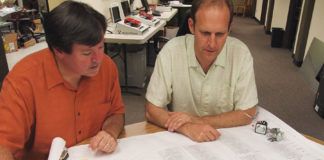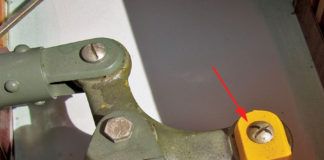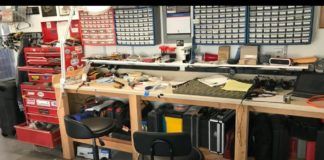Homebuilt aviation is not for folks who don’t try things at home.
—Bob Kuykendall, designer of the HP-24 sailplane
Every Labor Day weekend, members of the Experimental Soaring Association (ESA) hold their Western Workshop at Mountain Valley Airport, several hundred feet up a slope above Tehachapi, California. The 4000-foot altitude and the dry, hot climate make for sometimes-great soaring conditions, and astronauts trained there for even hotter flights. According to Janice Armstrong, who, with her husband, Dan, organizes the annual event, space-shuttle pilots flew in widely differing aircraft to ready them for the most different glider of all, one with a glide ratio that barely qualifies as such.
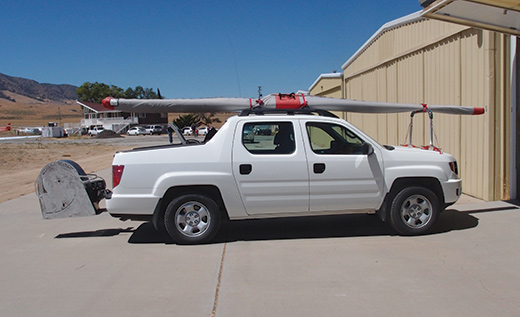
Dan Armstrong’s Ridgeline, ready to tow the hang glider up to 3000 feet in the air.
Presenters representing NASA, the industry, amateur aircraft builders and academia make the workshop an idea festival, sharing airy ideas with earthbound practicality. In Jeff Byard’s spacious (once all his vintage sailplanes are removed) hangar, presenters display practical approaches to flying in the greenest of aircraft. If it weren’t for the pollution-belching means of getting airborne, sailplanes would represent an environmentally-conscious pilot’s dream. As attendees learned, there are ways to counter even that minimal taint.
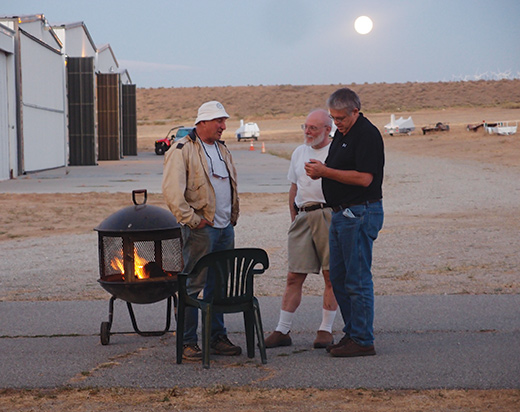
(Left to right) Jeff Byard, Murry Rozansky and Tom Navalenko under the first night’s blue moon.
Getting Aloft on a Budget
Dan Armstrong showed a practical example of a pickup-bumper-mounted payout/pay-in winch for ultralight sailplanes, hang gliders and paragliders, which can loft light soarers up to 3000 feet for less than even an ultralight aero tow. The “payout” part lets the pickup driver pay out line using a disk brake to provide a drag force as the towed vehicle gets higher when the pickup gathers speed. This works beautifully for open areas or long runways. The pay-in mode lets a stationary pickup act in winch mode, reeling in line as the towed vehicle gains altitude and ends up overhead. In both modes, the line is recovered by reeling in against the drag of a drogue chute. In normal operations, line and drogue fly directly back to the winch and never touch the ground.
Armstrong has achieved 3000-foot launches with 5500 feet of 7/64-inch Spectra line, experiencing no failures.
Gleaming on the rear of Armstrong’s Honda Ridgeline, the Honda industrial-engine-powered winch showed great workmanship and a well-designed way to miniaturize winch launching. The winch is designed and built by Justin Brim of Cloud Street Winch in Salt Lake City.
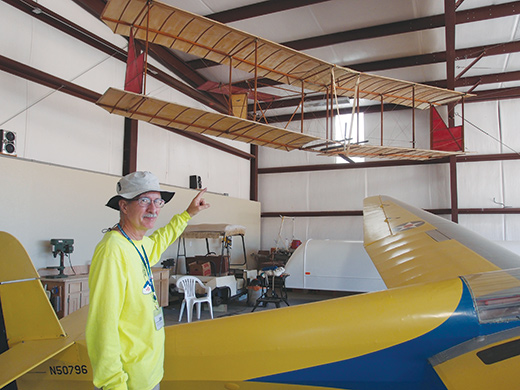
Doug Fronius shows off the Waterman Glider, an early homebuilt and one of many antique and modern gliders and sailplanes in Tehachapi’s hangars.
Homebuilders as Part of Soaring’s Past and Future
Byard presented his experiences flying one of a dozen historical sailplanes at Kitty Hawk, North Carolina, in 2011 as part of Soaring 100, a celebration of Orville Wright’s 1911 record flight over the sand dunes, a 9-minute, 45-second achievement standing for almost 10 years. Byard towed his Bowlus Baby Albatross and Schweizer TG-2, both wonderful reminders of America’s soaring history, across the U.S. for the ceremonies, and back to Tehachapi.
Raul Blacksten, the Vintage Soaring Museum’s archivist, titled his talk, “Homebuilding, Shomebuilding, Nothing to Learn Here.” Snarky title aside, he evinced only respect for the many homebuilders who have advanced sailplane aerodynamics over the years, from Orville Wright on, and found substance in the work of other “amateurs” such as Hawley Bowlus, Don Mitchell, Stan Hall and Dick Schreder. George Applebay and Danny Howell were on hand to hear their accomplishments lauded.
Murry Rozansky, ESA treasurer, had a more upbeat title, “Stairway to Heaven—A Few Steps to Save Soaring,” though he shared an underlying anxiety that we might lose a much-cherished sport. He, like others in the group, wants to find lower-cost ways to bring the sport to more people and is most interested in providing inexpensive training sailplanes for the movement.
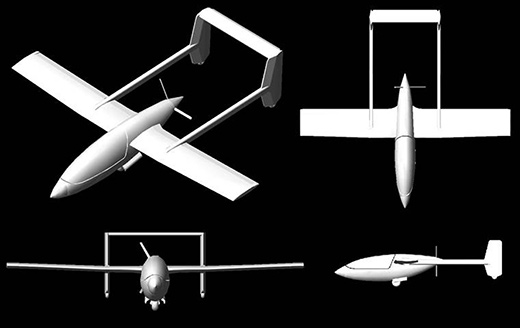
The Aria with shortened wings envisioned by John Washington.
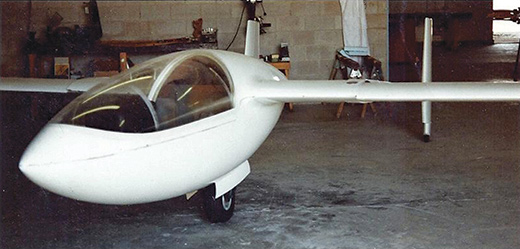
The nose of the Aria, showing its low frontal area.
Aria: A Dream Deferred
John Washington detailed his record flights in Alex Strojnik’s Laminar Magic, an improbably small airplane that achieved 125 mph on only 25 horsepower. This was the last airplane Strojnik would complete, and he allowed Washington to buy it for $1 so that he could insure it for a speed-record attempt. Having successfully flown, it was then sold back.
Several years ago, Washington found Sam Walker and his Aria self-launching sailplane, built with inspiration from Strojnik in hopes of achieving another world record. Washington thought this was one of the most beautiful aircraft in the world and bought it from Walker. He anticipates creating shorter, symmetrical wings and achieving a speed of 316 mph (275 knots).
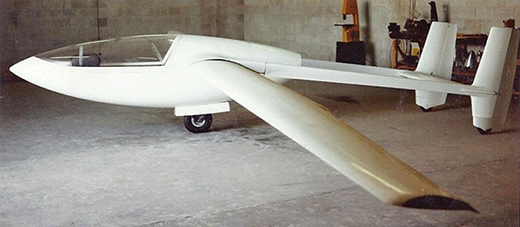
The Aria self-launching sailplane as purchased by Washington.
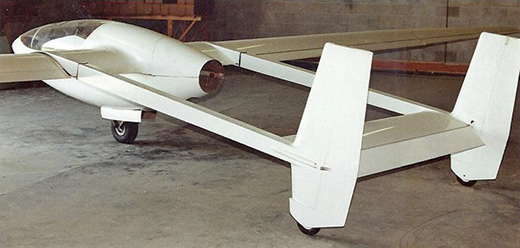
Rear three-quarter view of the Aria SLPS. The folding propeller would be well shrouded in the aircraft’s engine exhaust.
Windward, Upward and Onward!
Windward Performance’s Greg Cole showed off four major developments at his Bend, Oregon, company. His latest, the 15m-class DuckHawk, won the U.S. 15 Meter Nationals (first U.S. design to do so in 37 years) in May, and later in the season earned second place in the 18 Meter Nationals, missing first by a mere 19 points.
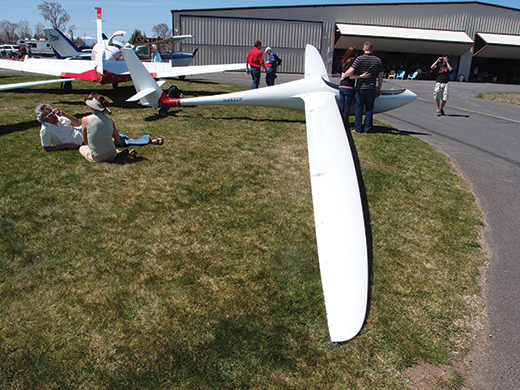
Windward Performance’s DuckHawk at its Bend, Oregon, rollout in April. Less than a month later, it won the Standard Class Nationals.
DuckHawk’s 30:1 aspect ratio wings have 11-G spars, yet weigh only 125 pounds each (SV model). These dynamic soaring wings allow pilot-squashing high-G maneuvers, a structural coup considering the average 19.5-inch chord and 2.5-inch wing thickness. All three models, V (Veloce, 390 pounds), SV (Super Veloce, 443) and VNX (Super Unchained, 455), have the same size wings, but Vne and structural limits increase with each model.
Fifty-four amp-hour batteries flex electric flaperons and retractable landing gear with trailing-arm suspension, allowing 4 inches of axle travel on its floating-piston oleo.
Cole says the flaperons “have very particular mass-balance requirements,” because of their thinness, narrow chord and high Vne in smooth air (V, 168 knots; SV, 200; VNX, 225). All speed limits apply up to 24,000 feet, so true airspeeds will be much higher.
An automatic flap-scheduling system in the works finds an ideal setting at all airspeeds and angles of attack, helpful during dynamic soaring maneuvers where the aircraft may transition between positive and negative G in only seconds. Wing water-ballast tanks can carry 220 pounds for a wing loading of 8-12 pounds per square foot, depending on the model and installed equipment.
DuckHawk’s unique fuselage water tank enables an air-conditioning system, a first in a sailplane and comprising an ice box, air pump and radiator—nice during warm moments.
A video Cole showed included the final stage of a race between the DuckHawk, at less than 11 pounds per square foot with water, and an open-class Arcus, near Minden, Nevada. Cole’s plane overtook and passed the Arcus at 148 knots true air speed, gaining over a full nautical mile on the other plane in just over 4 minutes.
A 72.2-foot (22-meter) super plane awaits introduction, with a wing area of 129.8 square feet, 1874 pounds gross weight with full water ballast, and a wing loading of 14.4 pounds per square foot.
DuckHawk could become the self-launching JetHawk with a 240-pounds-thrust TJ-100 retractable turbine engine, requiring an 8-inch fuselage stretch and a new vertical tail for lower drag, with slightly more area than the DuckHawk’s.
Windward is also working on the Cole-designed Perlan 2, a high-altitude research sailplane. Cole reported Perlan’s construction is well along; test fuselage and tail have undergone successful structural and pressurization tests. This assurance suggests progress toward a record altitude flight in 2013.
“A Tweety Bird with Attitude”
Resembling a Hershey-bar-winged Fournier RF-4D motorglider, the Robin ultralight demonstrated Mark Calder’s learning curve during its design and construction. The standard truss-braced wooden structure has many high-tech touches, including resin-infused leading edges and a wood-and-carbon-fiber landing gear.
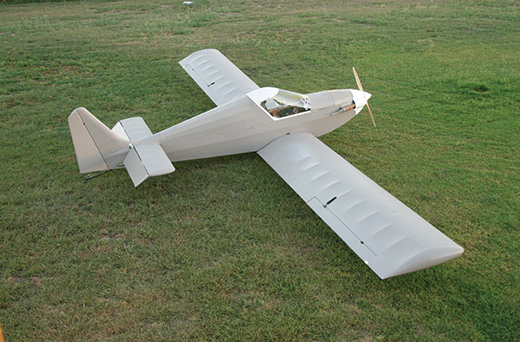
The simple gray Robin ultralight motorglider awaits its “Tweety with attitude” final color scheme.
Unfortunately, the clever landing gear prevented the airplane from being on hand, the mounting clamp having crushed the spruce core, causing it to slide out of the fuselage. Calder joked this basic design flaw caused him to fire the designer.
Back on the job at Tehachapi, he showed construction pictures of his surprisingly large ultralight, which has 40-foot-span rectangular wings and a long, slender fuselage giving graceful, Fournier-like lines. A “yarmulke” fiberglass cap over the pilot’s head allows a flat-wrapped canopy, although Calder confided considering a blown unit to make the airplane look even more RF-4D-like.
Calder shared several building tricks from his blog, filled with practical approaches. Using ammonia to soak ply-wing and tail leading edges, for instance, helps curve them into a perfect radius without spring-back, an invaluable help for a smooth airfoil. He avoids Styrofoam for structural parts, having seen disastrous results when gasoline spilled on an earlier project.
Calder should be flying his creation soon, and his well-documented building record should make it possible for others to emulate his effort.
A Standard-Class Sailplane You Can Build in a Garage
Bob Kuykendall’s 11 years of work on his HP-24 sailplane paid off when a smiling Brad Hill made the first test flights in late January this year. The 49.2-foot (15-meter) wingspan standard-class sailplane claims a 42:1 lift-to-drag ratio, and the 525-pound empty-weight craft can accommodate a 6-foot 2-inch, 240-pound pilot with ease. Its flapped wings can carry 200 pounds of water ballast to enhance penetration through sink, intervals shortened by its 120-mph rough-air maximum. In slower, weak-lift thermalling, the HP-24’s minimum sink of 1.8 feet per second at 46 mph helps. For those wanting more, wingtip extensions will increase span to 60 feet (18 meters), giving lower sink and a better lift/drag ratio.
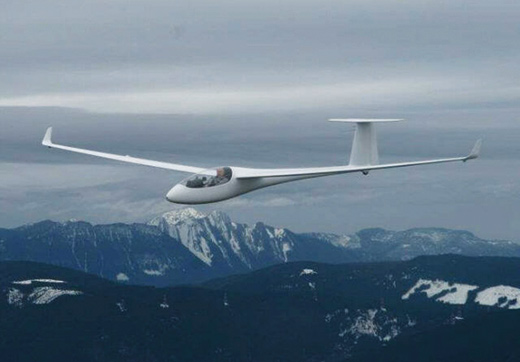
HP-24 on a January test flight with Brad Hill at the controls.
Kuykendall has done a great deal to help the homebuilder finish the pro-ject, shipping wing and fuselage components already bonded together and requiring only assembly of components such as control-system parts and landing gear. Production kits include everything to complete the aircraft other than paint, instruments and some “hazmat controlled resins.” Kuykendall insists that builders come to his workshop in Arnold, California, for at least two weeks, spread out over several visits if necessary, to help ensure quality completions. Total kit price is $32,348.72, but a 50% deposit guarantees $29,000, and sweat equity at his shop can lower that. Potential savings await builders willing to help with further developments, such as motorizing the aircraft.
A Bird of a Different Feather
Max Perrault and Bob Hoey, former flight engineers at Edwards Air Force Base, showed videos and a model of their fascinating low-aspect-ratio Pegasus, four artificial “feather” elevons sprouting from each side of its lifting-body pilot compartment. Perrault explored this design approach and shared simulator “flights” on Yahoo groups.

Max Perrault and Bob Hoey show off Pegasus.
The pair built a lightweight plywood and foam radio-controlled model, launched the electric ducted fan (EDF) craft from a bungee rail, and found the 15-ounce Pegasus was sensitive in pitch and roll. Air drops from a gas model mothership, something Hoey had perfected in testing bird models, and a higher exponential in the controls to slow responses, showed that Pegasus handled much like a “normal” aircraft. It was even stable at a 50° angle of attack, preceding a “nodding stall” with a normal recovery.
The pair tried different feather incidence angles, starting with a bird-like front-feather angle of -12.5° and the rest increasingly negative. They took out the two middle feathers on each side, making the craft a wide-body Rutan design. We’ll follow this unique concept as Perrault and Hoey add to their creative legacy.
High-Powered Liftoffs
Several speakers raised the power level considerably. Australian John Ashford described V-8-powered Pawnee tow planes in Oz, using LS-1 Corvette engines instead of the more common Lycoming IO-540. Ashford estimated that fuel, maintenance and related costs, compared to the Lycoming equivalent, would add up to $121,000 savings in one engine life, as shown in the table below.
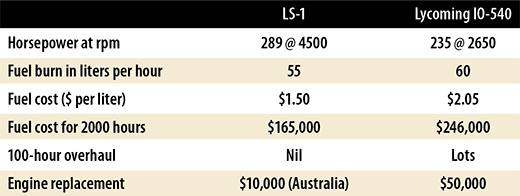
Al Bowers, associate director for research at NASA Dryden Flight Research Center, promised a talk on small, unmanned aerial vehicle glider experiments, but paid homage to Sally Ride and Neil Armstrong and showed videos of the Mars landing. Bowers authorized and signed for the use of the Mars landing radar on a NASA F-18, something that helped make the Curiosity mission a success. He finished with a brief rundown on his alternative view of wing lift distribution.
Retired General Joe Lanni wowed the powerless crowd with a detailed look at flying the F-22, a brute with 258,000 hp at its command.
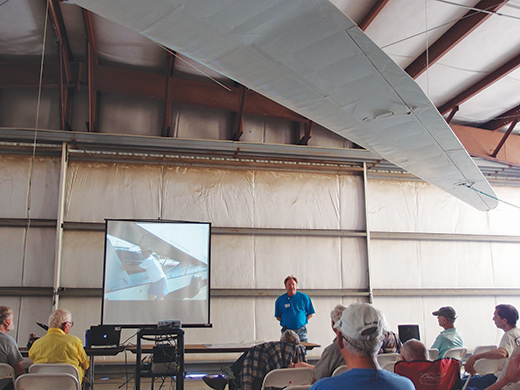
A NASA meteorologist explains the deep responsibilities of being a weatherman.
A NASA meteorologist gave a sobering rundown on the responsibilities and heartaches of weather forecasting, telling of the uncertainty and bad outcomes that are sometimes part of the job.
Always a source of elevated discourse, Phil Barnes synthesized a complex history of aerodynamics, showing how Prandtl, Jones, Helmbold and Polhamus had tried to characterize lift-slope curves for different wing aspect ratios and shapes (this is a wildly oversimplified synopsis). His web site (www.howfliesthealbatross.com) provides this lecture and many more delights.
This year’s event was the first not scheduled by Bruce Carmichael, a mentor to all of us in the Experimental Soaring Association. Presentation quality, as always, was excellent, and participation was enthusiastic. Put Tehachapi on your travel calendar for next Labor Day.

![]()
Dean Sigler has been a technical writer for 30 years, with a liberal arts background and a Master’s degree in education. He writes the CAFE Foundation blog and has spoken at the last two Electric Aircraft Symposia and at two Experimental Soaring Association workshops. Part of the Perlan Project, he is a private pilot, and hopes to get a sailplane rating soon.

